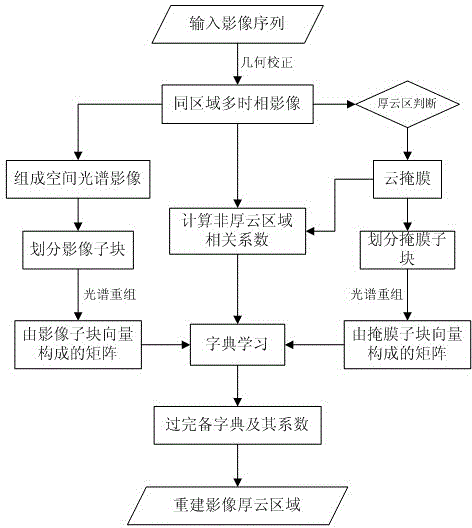Method for removing large-area thick clouds for optical remote sensing images through multi-temporal data
An optical remote sensing, multi-temporal technology, applied in image data processing, image enhancement, instruments, etc., can solve the problems of easily affecting image interpretation, incomplete removal of thick clouds, and inability to completely remove them, so as to improve the comprehensive application potential and improve radiation. quality effect
- Summary
- Abstract
- Description
- Claims
- Application Information
AI Technical Summary
Problems solved by technology
Method used
Image
Examples
Embodiment Construction
[0018] In order to make the purpose, technical solution and advantages of the present invention clearer, the method for removing large-area thick clouds from multi-temporal optical remote sensing images according to an embodiment of the present invention will be further described in detail below in conjunction with the accompanying drawings. It should be understood that the specific embodiments described here are only used to explain the present invention, not to limit the present invention.
[0019] The technical solution of the present invention can adopt computer software technology to realize the automatic operation process. The following combination figure 1 The specific steps for removing large areas of thick clouds in the embodiment are described in detail.
[0020] Step 1. Perform geometric correction on the multi-temporal image sequence to be processed to obtain images of different temporal phases in the same area.
[0021] The method for removing large-area thick c...
PUM
 Login to View More
Login to View More Abstract
Description
Claims
Application Information
 Login to View More
Login to View More - R&D
- Intellectual Property
- Life Sciences
- Materials
- Tech Scout
- Unparalleled Data Quality
- Higher Quality Content
- 60% Fewer Hallucinations
Browse by: Latest US Patents, China's latest patents, Technical Efficacy Thesaurus, Application Domain, Technology Topic, Popular Technical Reports.
© 2025 PatSnap. All rights reserved.Legal|Privacy policy|Modern Slavery Act Transparency Statement|Sitemap|About US| Contact US: help@patsnap.com



